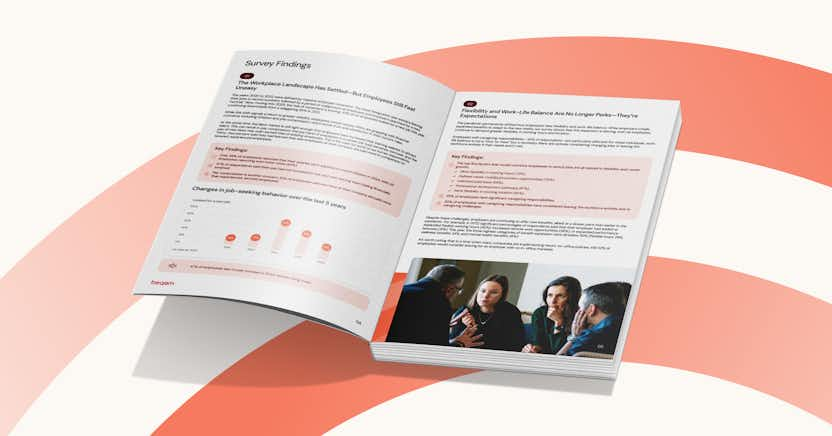5 Key Compensation Trends for 2024

As 2024 gets underway in earnest, we’re looking ahead at the hot topics for compensation professionals. We have identified five key compensation trends that are going to have an impact on organizational strategies in the coming months and years.
Keeping pace with these trends will help ensure your compensation strategies are successful in attracting and engaging talent and achieving top and bottom-line performance.
1) Overcoming pay compression and internal pay inequities
We’ve seen record growth in salary budgets these past few years and while that’s set to slow down—with most analysts settling on around 4% for this year's budget, compared with 4.6% last year—that’s still record growth compared to pre-pandemic years.
Forbes cites that employers continue to point at inflationary pressures and concerns over a tight labor market as the primary influencing factors behind salary increase budgets, and predicts that salary increases will exceed inflation in 2024, as they did in 2023.
The U.S. Bureau of Labor Statistics reported that job openings at the end of December 2023 stood at 9 million, down from a high of 12.0 million in March 2022 but still a significant number and an indication that businesses are still facing a talent shortage.
The race to attract and retain talent has come at a cost and pay compression continues to rear its ugly head, with newcomers often attracting higher wages than existing employees, leading to internal inequity. The impact of all of this gets us right back to basics, with compensation teams gearing up to address internal pay inequities in all of their forms.
Some companies may employ segregated compensation budgets—separate budgetary pools for different groups of employees— in an attempt to combat wage compression, provide flexibility, and target specific needs within different segments of the workforce, but this practice also can have implications for pay equity and may contribute to pay inequities in the organization.
As market pressures and regulatory requirements for pay equity and transparency increase, firms are looking to get on top of internal inequities and close their gender pay gaps. Pay equity adjustments are becoming the norm throughout the year, no longer limited to the annual compensation cycle. AI-based compensation management software is helping companies implement always-on pay equity.
2) Meeting the imperative for pay transparency
Our next trend—pay transparency—can’t be avoided. It’s not just a market trend, it’s fast becoming a legal obligation, with legislation evident in at least ten US States and the EU Pay Transparency Directive. At the same time, job seekers are expecting employers to have fair and transparent pay practices. There’s no getting away from the reality that transparency is moving to front and center of the compensation agenda.
It’s not without its challenges. A recent Willis Towers Watson survey showed that 33% of companies cited their pay programs simply weren’t ready for pay transparency. And of course, implementing pay transparency demands a clear job architecture and job leveling framework, where a lot of organizations may need to catch up.
On the positive side, WTW also reported that 73% of companies believe the legislation is encouraging increased levels of pay communication. So this trend is here to stay, and getting prepared for it is a critical task for every compensation professional.
“Pay transparency is not about publishing everyone’s salaries, it simply means being open and honest about why we make pay decisions.”
-Rameez Kaleem
beqom surveys over the last few years have clearly shown that employees and job seekers are expecting transparency around pay, and don’t feel that employers are doing enough to deliver it. More than half of US employees in 2023 thought their workplace had a problem with a gender pay gap–up 121% since 2019. And, nearly two in five employees do not think they’re paid fairly. In the UK, more than half do not think enough has been done to address the UK’s gender pay gap.
In a previous beqom Compensation and Culture report, a perceived lack of transparency fueled a feeling among roughly a third of respondents that employers do not pay workers fairly. About 1 in 5 workers said they believe companies are deliberately secretive around the disclosure of salary and bonus information, while 1 in 4 said it was because their pay was lower than the same role at a competitor. One in 10 said they don’t think their company pays employees fairly because they don’t have any insight into why they’re paid their current salary.
Clearly, transparency—and communication thereof—can do a lot to help employees understand how and why they are paid, dispel misconceptions, and create trust that they are being paid objectively and fairly.
3) Communicating about pay to create trust
The implications of pay transparency bring us to our next trend, communication. Rameez Kaleem, author of ‘A Case of the Mondays’ and renowned expert on pay transparency and trust, says that communication around pay is critical to establishing trust with employees. In the absence of information about pay decisions, notes Kaleem, employees make their own assumptions.
“Pay transparency is not about publishing everyone’s salaries,” says Kaleem. “It simply means being open and honest about why we make pay decisions.” Transparency builds trust and trust builds motivation and loyalty.
Now that pay transparency is on the march we need our managers to be equipped to understand and articulate the company’s pay philosophy, relevant pay ranges, and positions, without running to HR for help whenever the employees want detailed answers. Only 2 in 5 organizations reported that they are effective at educating managers on pay and pay equity issues in a recent WTW survey. So, much work needs to be done to educate and prepare our managers for our new world of transparency. Here are some strategies to achieve this:
- Clarify the company's pay philosophy: Clearly articulate the company's pay philosophy, including the principles and values that guide compensation decisions. Ensure that managers understand and can communicate how pay aligns with performance, market benchmarks, and the organization's overall goals.
- Provide training and resources: Conduct training sessions or workshops to educate managers on the company's pay philosophy, compensation structure, and relevant pay ranges for different positions. Develop guidelines or scripts to help managers communicate pay-related information consistently and effectively.
- Highlight total rewards: Encourage managers to discuss not only base salary but also the comprehensive package of total rewards, including benefits, bonuses, and other perks. This provides employees with a more holistic understanding of their overall compensation. Believe it or not, a recent beqom survey found that nearly half of all employees don’t understand their total compensation.
- Encourage open dialogue: Foster a culture of open communication by encouraging managers to engage in two-way conversations with their teams. Create forums where employees can ask questions about pay practices, and ensure that managers are prepared to address these inquiries openly and honestly.
- Emphasize fairness and consistency: Stress the importance of fairness and consistency in pay decisions. Managers should communicate that pay is determined based on objective criteria, such as performance, skills, and market benchmarks, rather than favoritism or arbitrary decisions.
- Address pay compression and inequities: Train managers to recognize and address pay compression and inequities. Equip them with strategies to communicate changes in compensation structures and the rationale behind these adjustments to affected employees.
- Seek feedback: Encourage managers to seek feedback from employees about their understanding of the company's pay philosophy and practices. This feedback loop can help identify areas that may need further clarification or improvement.
- Model transparent behavior: Leadership should model transparent behavior by openly discussing pay philosophies and practices. When employees see leaders being transparent about compensation, it sets a positive example for managers to follow.
By investing in manager education and communication strategies, organizations can promote a culture of trust and transparency around pay practices, contributing to greater employee satisfaction and engagement.
4) Auditable performance management
Related to the ability to explain a pay range or compensation decision is the inevitable link to performance. With most organizations opting for a pay-for-performance strategy, it’s no longer enough to tell an employee that they received a certain rating, you need to be able to document and explain how you got to that rating, and provide assurance that it was fair and objective.
Auditable performance management involves the systematic documentation of employee performance ratings. This requires our performance management systems to capture both structured and unstructured data relating to employee performance. Having measurable goals and peer feedback are two ways to help ensure that the performance process is auditable, objective, and fit for purpose so that managers are empowered to make data-driven decisions about pay.
Measurable goals play a crucial role in an auditable performance management system. Employees should have well-defined, quantifiable objectives that contribute to the overall success of the organization. Including peer feedback and 360-degree reviews adds a valuable dimension to performance evaluations. This provides a more comprehensive view of an employee's contributions and impact on the team and organization.
An auditable performance management system promotes fairness and equity by ensuring that all employees are evaluated using consistent criteria. This consistency is vital for maintaining trust and confidence in the performance evaluation process. When compensation decisions are linked to performance, employees are more likely to accept outcomes if they believe the process is fair and transparent.
Auditable performance management is essential for compliance with legal and regulatory requirements as well. Having a well-documented performance evaluation process can be crucial in case of disputes or legal challenges related to compensation decisions, by demonstrating that the organization followed a fair and objective process in determining pay.
Lastly, an auditable performance management system allows organizations to continuously improve their processes. By analyzing performance data and feedback, organizations can identify areas for enhancement in their performance evaluation and compensation practices.
The integration of auditable performance management practices is essential for organizations implementing pay-for-performance strategies. It helps establish transparency, fairness, and accountability in the performance evaluation process, enabling organizations to make well-informed and defensible compensation decisions.
5) Automating processes with AI
Finally, with all this communicating to do and educating of our populations on pay transparency, it’s time to ditch manual processes and embrace AI. AI has permeated every facet of work and compensation is no different. Helping automate those manual tasks we can finally ditch the spreadsheets and let AI step in to do those things that let’s face it, rarely inspired anyone. We see this as a key step in automating the compensation function so that compensation professionals can focus on the strategic matters at hand.
AI can automate various HR compensation and performance processes, streamlining workflows and improving efficiency. Here are just a few examples of compensation processes that can be automated with AI:
- Compensation prediction modeling: Helps you run any compensation prediction scenario based on historical data and industry benchmarks, so you can make more informed and unbiased pay decisions for merit increases, promotions, transfers, or new hires.
- Managing pay equity: By apply advanced analytics and machine learning you can uncover and prevent unexplained pay gaps to ensure fair pay, reduce unwanted attrition, and support regulatory and compliance mandates.
- Compensation planning: AI-powered tools can assist in developing and optimizing compensation plans. By analyzing various factors, such as budget constraints and market trends, AI helps create fair and competitive compensation structures.
- Workforce Analytics: AI-powered analytics tools can process large volumes of HR and performance data to generate insights. This includes identifying trends, predicting turnover risks, and optimizing workforce planning.
So here’s to 2024 and beyond, as we apply newfound technologies to overcome internal inequities, eliminate gender pay gaps, embrace pay transparency, and just maybe, finally say goodbye to manual spreadsheet processes. The future of compensation is bright!
















